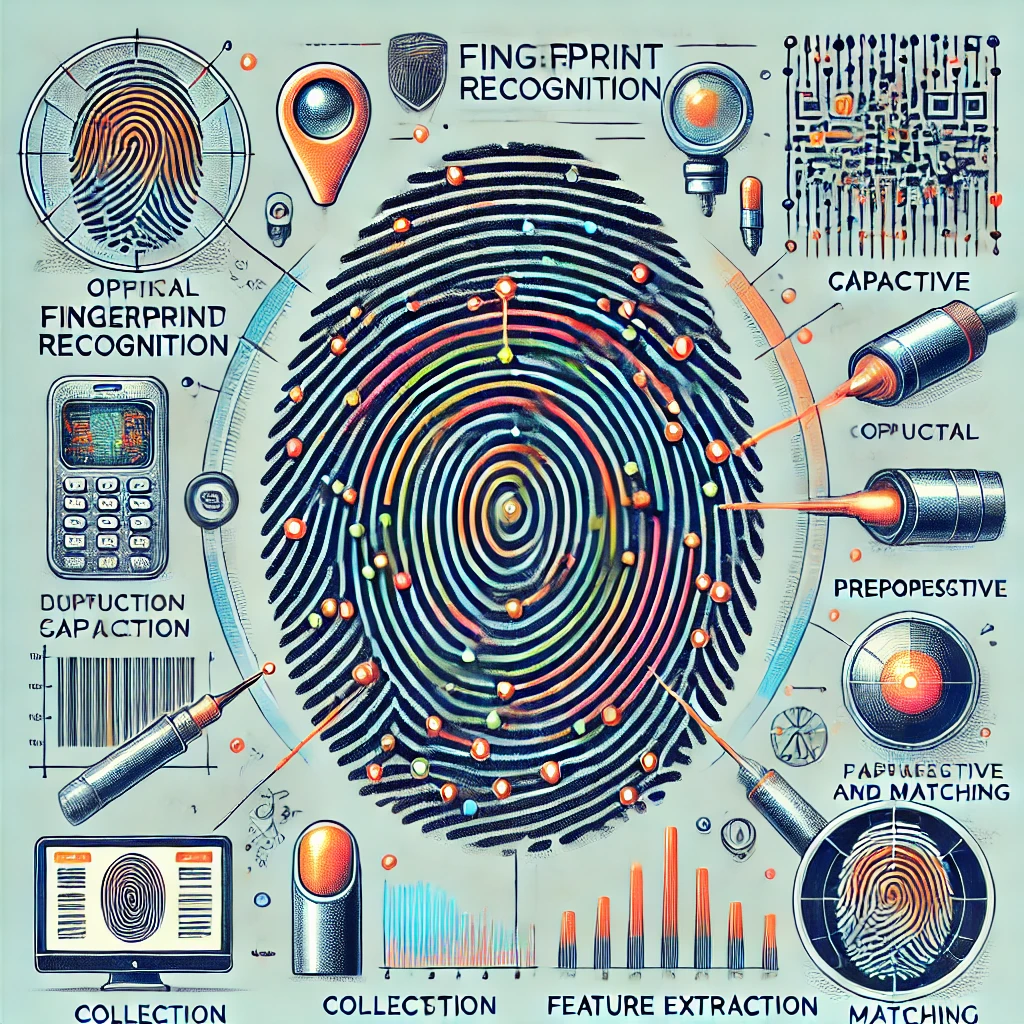A fingerprint is a regular flowing pattern of ridges from the dermis to the epidermis of a finger, which is used as biometric information that is important for identification because it does not change throughout life. Fingerprint recognition systems are categorized into optical, capacitive, and pyroelectric sensor types, each of which uses different principles to acquire fingerprint images to verify identity. Fingerprint recognition systems are categorized into optical, capacitive, and pyroelectric sensors, each of which uses different principles to acquire fingerprint images to verify identity.
Fingerprints are made from the dermis of the finger where the sweat glands are raised to the epidermis in a certain flowing shape, and the raised parts are called ridges and the indentations are called bones. Fingerprints remain unchanged throughout life as long as the dermis is intact. For this reason, fingerprints, along with irises, veins, and voice, are widely used as important biometrics for identification. Fingerprints have a unique pattern on each finger, which is very effective in distinguishing the identity of each individual.
Fingerprint recognition systems are biometric identification systems that verify identity by determining whether an enrolled fingerprint is the same as the fingerprint being looked up. In order to enroll or retrieve a fingerprint, a fingerprint enrollment device is used to obtain an image of the fingerprint that shows the ridges and bones of the finger. The fingerprint input device obtains information through contact with the finger, where the ridges of the finger are in contact with the contact surface and the bones are not. Therefore, there are differences in physical quantities such as light intensity, electric charge, and temperature corresponding to the ridges and bones of the fingerprint input device.
An optical fingerprint reader consists of an illuminator, a prism, and an image sensor. When a finger is placed on the reflective surface of the prism, moisture or oil on the ridges forms a thin film on the reflective surface. The light from the illuminator is refracted or scattered and arrives at the image sensor in a weakened state. The bone does not touch the reflective surface, so the light is reflected without refraction or scattering and reaches the sensor. The image sensor converts the light intensity into a digital signal to create an image of the fingerprint. It is difficult for this device to obtain a complete fingerprint image if the fingerprint is a dry fingerprint with little sweat or oil in the area where the fingerprint is located.

A capacitive sensor fingerprint input device uses a plate with tiny capacitive sensors closely spaced. The plate is electrified and each sensor has a constant charge. When a finger touches the plate, the charge is discharged, reducing the amount of charge on the sensor. The difference in charge between the sensor that touches the ridge and the sensor that doesn’t is then converted to obtain a fingerprint image.
A pyroelectric sensor fingerprint input device uses multiple small pyroelectric sensors that detect temperature changes in the human body and are arranged in a line about the same length as the width of a finger. These sensors are characterized by the fact that they only generate a signal when the temperature changes. When you move your finger with the sensor in contact in a direction perpendicular to the direction in which the sensors are lined up, frictional heat is generated between the contact surface and the ridges of the fingerprint, causing the temperature of the sensor to vary along the ridges and valleys. The sensor detects the slight temperature change at this time, converts the corresponding signal, and stores it continuously to obtain a fingerprint image. This device can be miniaturized compared to other fingerprint input devices, so it can be mounted on a small device such as a smartphone.
In general, biometric systems go through the following steps: biometric information collection, pre-processing, feature data extraction, and matching, and fingerprint recognition systems follow the same process. Biometric acquisition is the process of obtaining a fingerprint image using a fingerprint input device. The preprocessing stage removes image information that is irrelevant to the shape of the fingerprint, and adjusts the fingerprint image to highlight the features of the fingerprint shape. Noise removal and image enhancement are performed during this process. In the feature data extraction stage, the unique feature data of each fingerprint is extracted from the preprocessed image. The feature data includes the type of distribution of the ridges, the location of the ridges and their connection status. In the matching step, the similarity is calculated by comparing the pre-registered feature data with the feature data extracted for fingerprint lookup. If the value is greater than the threshold, it is determined that the fingerprint belongs to the same person.
Fingerprint recognition technology plays an important role in increasing security. It’s used in banks, airports, smartphones, and more, and it’s highly accurate and convenient. However, fingerprint recognition systems are not perfect. They can fail in certain environments, and there are various attempts to evade or fool fingerprint recognition. Therefore, fingerprint recognition technology should be used in conjunction with other security measures and requires continuous research and improvement.
Fingerprint recognition systems will remain an important biometric technology in the future, and as technology advances, they will become more sophisticated and reliable. It is hoped that the accuracy and security of fingerprint recognition will be further improved through various research and development.